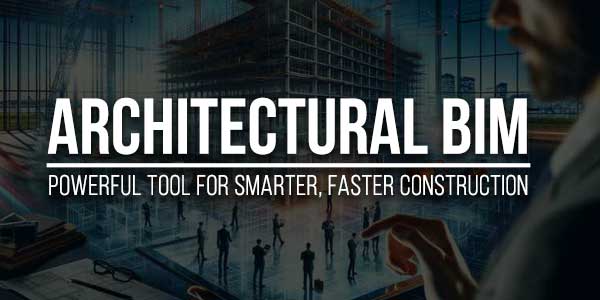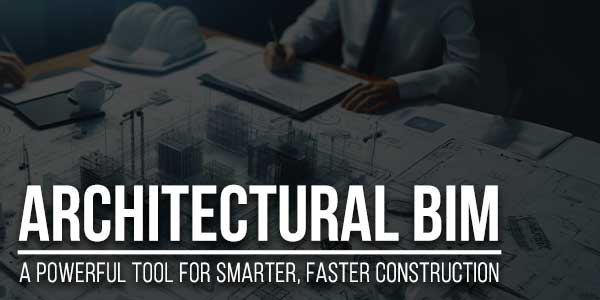
Building Information Modeling (BIM), a digital representation of the physical and functional characteristics of a building has been revolutionizing the architecture, engineering, and construction (AEC) industry. It’s not just a fancy 3D model of a building; it is a powerful tool that allows architects, engineers, and constructors to visualize, simulate, and analyze how a building will perform in the real world, even before it’s built.
As a result, BIM has been helping the AEC industry shift from traditional 2D drafting to a more integrated, collaborative, and efficient approach to building design and construction. This article will explore how architectural BIM is making construction smarter and faster.
Table of Contents
Efficiency And Accuracy:
The 3D modeling capabilities of BIM allow architects and engineers to design buildings with more precision and detail. Unlike 2D drawings, which can be difficult to interpret and prone to errors, a 3D BIM model gives a realistic, holistic view of the building. This helps in detecting and resolving potential design issues early in the process, thus reducing costly reworks and delays during construction.
Moreover, architectural BIM services can store a wealth of information about the building’s components—such as materials, dimensions, and manufacturer details—in a centralized database. This digital information can be easily updated, accessed, and shared by all project stakeholders, enhancing the accuracy and consistency of design data.
Collaboration And Coordination:
BIM promotes a collaborative approach to building design and construction. With BIM, all project stakeholders—from architects and engineers to contractors and facility managers—can work on the same model, in a coordinated manner. This facilitates seamless communication, teamwork, and decision-making throughout the project lifecycle.
Also, BIM can perform ‘clash detection’—identifying interferences or ‘clashes’ between different building systems (e.g., structural, mechanical, electrical, and plumbing) in the design stage itself. This helps in resolving conflicts and optimizing solutions collaboratively, preventing on-site clashes that could cause delays and increase costs.

Simulation And Analysis:
Another significant advantage of BIM drawing services is their ability to simulate and analyze building performance. For example, BIM can simulate how a building will consume energy, how it will be affected by sunlight and shadows, or how sound will travel within it. This helps in designing more sustainable, energy-efficient buildings.
Furthermore, BIM can enable ‘4D’ and ‘5D’ modeling—adding dimensions of time and cost to the 3D model. 4D BIM can visualize the construction sequencing and scheduling, while 5D BIM can estimate and track the project cost. These advanced capabilities can aid in better planning, scheduling, and cost management, leading to faster, more economical construction.
Future-Ready Construction:
As the construction industry moves towards digital transformation, embracing BIM can provide a competitive edge. BIM can integrate with emerging technologies like augmented reality (AR), virtual reality (VR), artificial intelligence (AI), and Internet of Things (IoT), offering exciting possibilities for smarter, technology-driven construction.
For instance, with AR/VR, stakeholders can ‘walk through’ the BIM model, experiencing the building design in a more immersive, intuitive way. AI can leverage the rich data in BIM for predictive analytics, machine learning, and automation. IoT can connect BIM with real-time data from sensors and devices, enabling dynamic, responsive building operation and maintenance.
BIM And Regulatory Compliance:
Building regulations and standards are an integral part of the construction industry, aiming to ensure the safety, health, and sustainability of buildings. BIM can assist in meeting these regulatory requirements more effectively.
With BIM, architects can embed codes and standards into the model, checking the design’s compliance automatically. This not only reduces the risk of non-compliance but also saves the time and effort spent on manual checking. Also, BIM can generate compliance reports and documentation, facilitating smoother approval processes.
BIM And Facility Management:
BIM’s value extends beyond the design and construction phase—it can also contribute significantly to facility management. The data-rich BIM model can serve as a reliable, up-to-date source of building information for facility managers.
This can support various facility management tasks, such as space management, asset management, maintenance planning, and energy management. For example, the BIM model can provide details about the building’s equipment, including its location, specifications, and maintenance history, helping in efficient, proactive facility management.
The Conclusion:
In conclusion, architectural BIM is not just a trend; it’s a powerful tool that is reshaping the way we design, build, and operate buildings. By adopting BIM, the AEC industry can achieve smarter, faster, and more sustainable construction, delivering better value to clients and society.


















Be the first to write a comment.